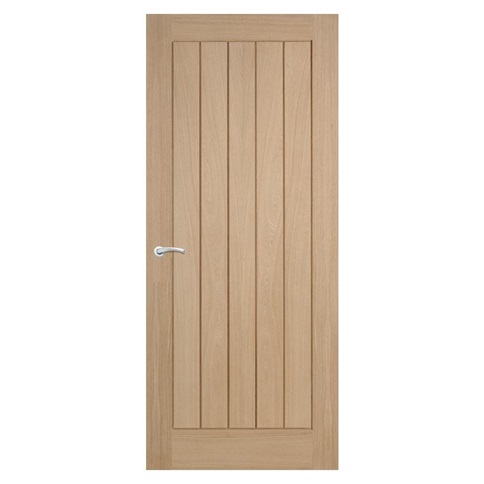Doors and fittings, so many options the mind boggles! Here we help you cut through the noise, and make decisions that will suit your lifestyle.
Part of our Finer Details series looking in depth at a particular feature for your home, to help you make great decisions that will suit your lifestyle for years to come.
Share:
Doors - Materials, finish and style

Pictured is an example of Howden’s Dordogne Oak veneered door, which has been popular with many other clients, and is often our default specification. You can view these doors in situ at these properties in our portfolio: Royal Garden and Seaside Home.
We generally find that Howdens offers a good quality range of doors and accessories at reasonable prices, with good availability. To purchase from them you need to have a trade account, which most of our regular contractors have with local branches, however you are welcome to visit a branch closer to you to discuss their full range.
If you don’t expect to finalise the exact type of door before the building works commence, the Dordogne product offers a good cost to put into the contractA legal document signed by both the client and the service provider, which sets out the detail of the services to be provided, and any constraints, and how the project should be managed. We typically will use the JCT Design and Build Contract, depending on the service you choose., and hopefully comparable with the door you’ll finally choose.

Door frames
While you’re still thinking about the colour and wood, you need to think about whether the door frames need to match the door panels. Mixing materialsBricks, concrete, timber, cement, nails, screws, and everything else that makes up the building. is quite standard – e.g. oak panel and white painted frames, allowing the frame to blend into the wall.
The other question is whether to use a door lining or a door casing.
Door linings are the “traditional style”, where a door stop is nailed to the frame and is visible from the “outward” side.

Door casings have a more contemporary style as the stop element is incorporated into the frame, and the door leaf is rebated. From the outside the frame has a flush appearance.

The architrave style is often similar to the skirting, and both are often referred to as Mouldings. Please have a look at Howdens pages for inspiration.
Door accessories and ironmongery
An early choice for many is the finish of the door handles and locks. There is a vast array of finishes available including differing colours and surface textures, which should be able to meet any personal taste, although there might be other factors to consider.
The range of finishes for the “utilitarian” hardware (hinges, latches and bolts) are generally more limited, and therefore might influence your choice of the tactile items.
If you are to have any other metal finishes, such as light switches or trims, this might be another consideration to ensure a complementary palette of colours and materialsBricks, concrete, timber, cement, nails, screws, and everything else that makes up the building..
Howdens or Jeb Supplies offer a good selection of door accessories. We’d recommend visiting Howdens for advice on style and fittings.

Handle style
Initially, would you prefer Latch handles, Rose handles, or Mortice knobs?
A latch handle mounts the handle on a backplate, which can offer a bit of protection against finger marks, but also can incorporate any key or thumb-turn or key operated locks.
Rose handles and mortice knobs detach the handle/knob from any locks.
Locks
What type of locks do you require, and on which doors? Bathrooms, and toilets, obviously, but are there other rooms that you may wish to restrict access to, from inside or outside?
Thumb-turn locks
These are the most common for domestic use, and our default for bathrooms and toilets, as they provide a screw operated release slot on the outside for emergency access (a requirement for disabled users, and really handy if you have toddlers!).
Depending on the supplier and preference, there can be two thumb-turn types – Privacy and Bathroom.
The bathroom type, like a key operated lock, slides across a bolt, which is independent of the adjacent handle.
Key locks
Depending on your handle style, these can be incorporated into the backplate, or as a separate key hole. These are most common on exterior doors, but may also be used on home offices, guest rooms, or other areas where you need to restrict access, for example if you are using the property as a holiday let and need to keep your own belongings secure.
If incorporated in the backplate, an integral sashlock is appropriate.
Where separate, the key hole is often “tidied” with an escutcheon plate, sometimes with a cover. Depending on the plate size, and proximity to the handle, a sashlock can be used. Otherwise a detached deadlock might be necessary.
Hinges
Historically three hinges are recommended per door leaf for commercial installations, however this has filtered through to domestic projects, to prevent settlement and improve longevity. We recommend mounting two near to each other toward the top of each door leaf, and the third toward the bottom. We suggest ball-bearing hinges generally.
Self-closing hinges
Fire doors require self-closers, but sometime people prefer toilet and bathroom doors to close themselves too. In these situations, self-closing hinges can provide a better alternative than over-head arms, often seen in commercial situations. Would you like these on any of the doors?

We are happy to discuss doors and door fittings with you at the appropriate stage in your build, to ensure that everything works, and looks, exactly how you need it to.




